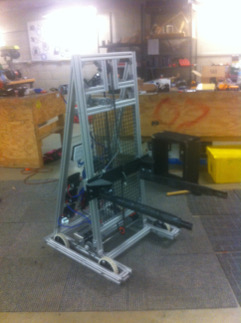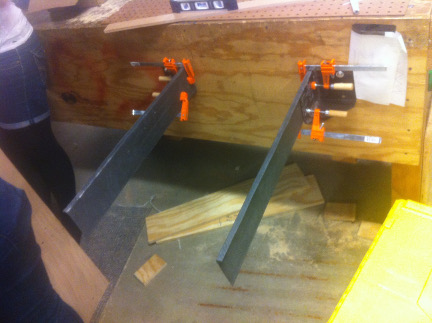Composite Forklift Arms

During my final year of high school, our FIRST robotics team had the task of creating a robot that stacked recycling totes. I thought that our best chance at advancing to the next tournament was to win the innovation award. Composites are rarely seen in competition, so I thought it was an opportunity to stand out amongst the other teams. All versions of the arms were constructed between January-May 2015.
Technical
Pre-season, I befriended a person who works with composites for marine applications. We hosted a class where our entire team learned the basics about composite materials and assembly. From there we formed a small team to work on the arms.
For sake of simplicity, our first arms were simply long rectangles that jutted out from right angle brackets. Three layers of carbon fiber flanked a core of thick fiberglass, for a total of seven layers. After wetting each side with a two-part epoxy, we clamped down the arms on sheets of acrylic, and allowed for the piece to cure overnight. The next day, we trimmed the edges on a bandsaw, drilled mounting holes, and touched up stray edges with additional epoxy.
The arms proved two flexible, so we cut added aluminum bars to stiffen them. Now, the arms held the tote snugly. We had extra carbon fiber oars, so we cut one lengthwise, replaced the aluminum bars with them, and wrapped the entire piece with more carbon fiber.

When we added the oars for stiffness, the extra girth caused the tote to easily slip.
When we added the oars and extra material, the additonal girth caused the tote to easily slip out of the arms.
Starting from scratch, we designed new arms with and elongated “L” proflie. Now, the arms were stiff, lighter than the previous version, and had a low profile.
Result

Our new, low-profile version of the arms awaits testing.
Review
What went well:
- Arms were overall a success. They held the tote most of the time.
- Arms were lighter than comparable alloy versions.
- This was the first time we used composites.
Not so hot:
- During fast turns, the tote slipped out.
- Arms did not have much torsional rigidity, causing the aforementioned problem.
- The fit and finish were subpar, partly due to lack of precision cutting tools.